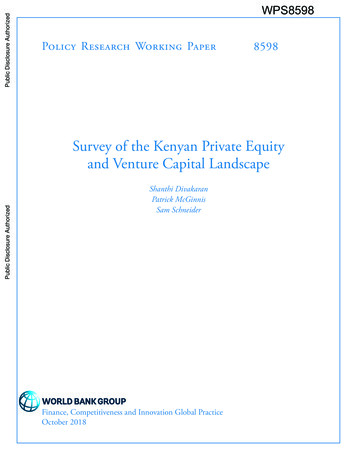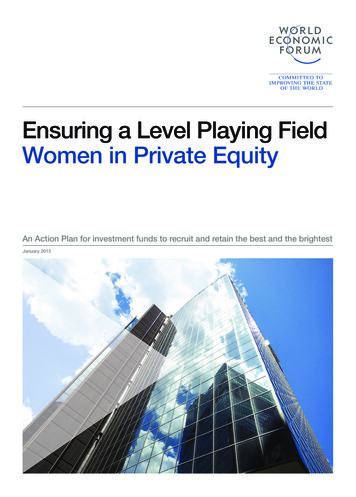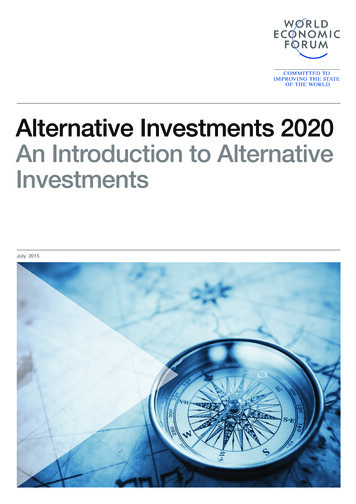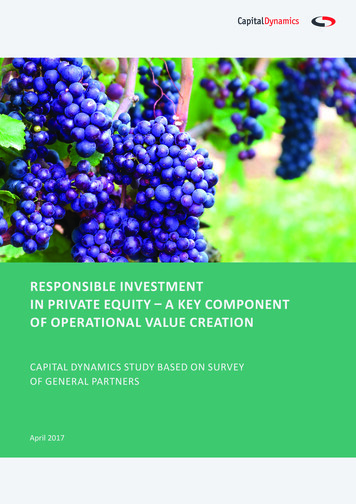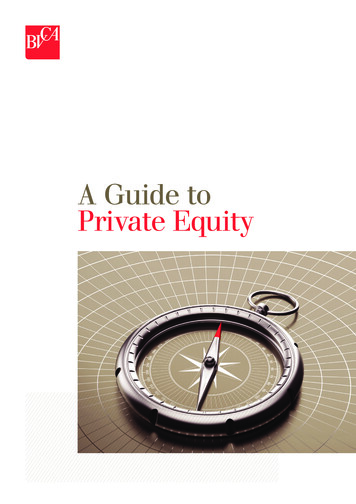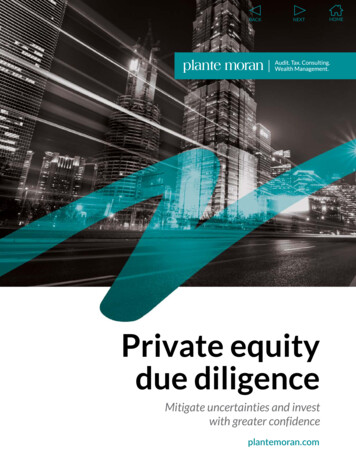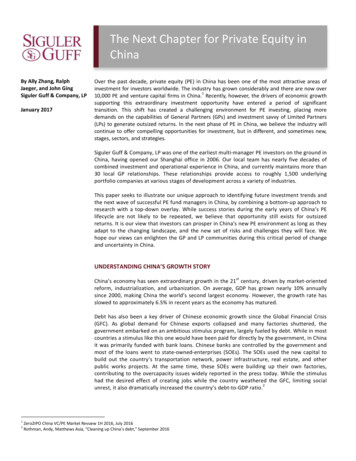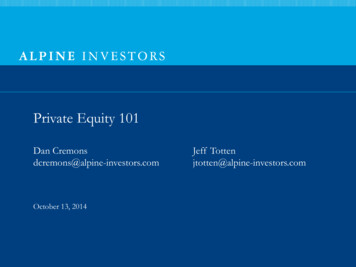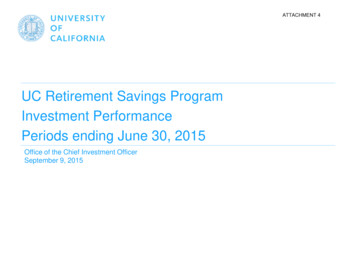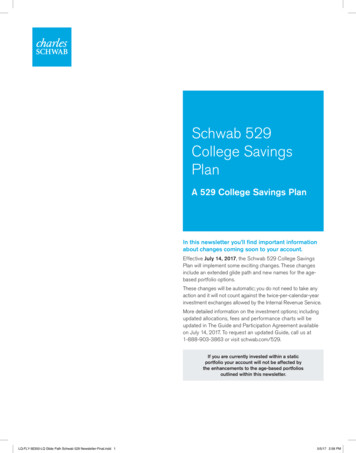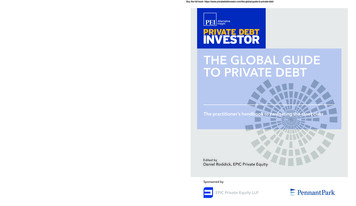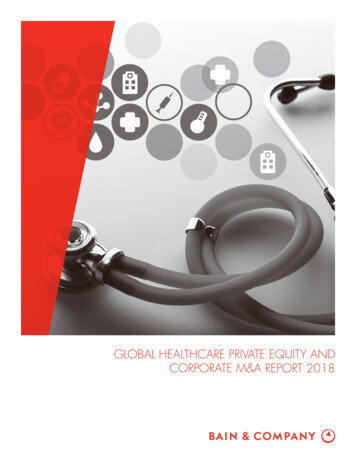
Transcription
GLOBAL HEALTHCARE PRIVATE EQUITY ANDCORPORATE M&A REPORT 2018
This work is based on secondary market research, analysis of financial information available or provided to Bain & Company and a range of interviewswith industry participants. Bain & Company has not independently verified any such information provided or available to Bain and makes no representationor warranty, express or implied, that such information is accurate or complete. Projected market and financial information, analyses and conclusions containedherein are based on the information described above and on Bain & Company’s judgment, and should not be construed as definitive forecasts or guaranteesof future performance or results. The information and analysis herein does not constitute advice of any kind, is not intended to be used for investment purposes, and neither Bain & Company nor any of its subsidiaries or their respective officers, directors, shareholders, employees or agents accept any responsibility or liability with respect to the use of or reliance on any information or analysis contained in this document. Bain & Company does not endorse, andnothing herein should be construed as a recommendation to invest in, any fund described in this report. This work is copyright Bain & Company and maynot be published, transmitted, broadcast, copied, reproduced or reprinted in whole or in part without the explicit written permission of Bain & Company.Copyright 2018 Bain & Company, Inc. All rights reserved.
Global Healthcare Private Equity and Corporate M&A Report 2018ContentsAbout Bain & Company’s Private Equity business . . . . . . . . . . . . . . . . . . . . . . . iiWelcome letter . . . . . . . . . . . . . . . . . . . . . . . . . . . . . . . . . . . . . . . . . . . . . . 11.Healthcare private equity market 2017: The year in review . . . . . . . . . . . . . . . 3Spotlight: The five forces disrupting healthcare . . . . . . . . . . . . . . . . . . . . . . . . 52.Geography trends . . . . . . . . . . . . . . . . . . . . . . . . . . . . . . . . . . . . . . . . . . . . . . 9Overview . . . . . . . . . . . . . . . . . . . . . . . . . . . . . . . . . . . . . . . . . . . . . . . . . . 9North America . . . . . . . . . . . . . . . . . . . . . . . . . . . . . . . . . . . . . . . . . . . . . 11Europe . . . . . . . . . . . . . . . . . . . . . . . . . . . . . . . . . . . . . . . . . . . . . . . . . . .13Asia-Pacific . . . . . . . . . . . . . . . . . . . . . . . . . . . . . . . . . . . . . . . . . . . . . . . . .153.Sector trends . . . . . . . . . . . . . . . . . . . . . . . . . . . . . . . . . . . . . . . . . . . . . . . 18Overview . . . . . . . . . . . . . . . . . . . . . . . . . . . . . . . . . . . . . . . . . . . . . . . . . 18Provider and related services . . . . . . . . . . . . . . . . . . . . . . . . . . . . . . . . . . . 19Payer and related services . . . . . . . . . . . . . . . . . . . . . . . . . . . . . . . . . . . . . 22Biopharma and related services . . . . . . . . . . . . . . . . . . . . . . . . . . . . . . . . . 24Medtech and related services . . . . . . . . . . . . . . . . . . . . . . . . . . . . . . . . . . . . . 27Healthcare IT . . . . . . . . . . . . . . . . . . . . . . . . . . . . . . . . . . . . . . . . . . . . . . 294.Corporate M&A . . . . . . . . . . . . . . . . . . . . . . . . . . . . . . . . . . . . . . . . . . . . . 325.Exit activity . . . . . . . . . . . . . . . . . . . . . . . . . . . . . . . . . . . . . . . . . . . . . . . . 37Spotlight: What funds can learn from deep operational due diligence . . . . . . . 406.2018 and beyond . . . . . . . . . . . . . . . . . . . . . . . . . . . . . . . . . . . . . . . . . . . 42i
Global Healthcare Private Equity and Corporate M&A Report 2018About Bain & Company’s Private Equity businessBain & Company is the leading consulting partner to the private equity (PE) industry and its stakeholders.PE consulting at Bain has grown sevenfold over the past 15 years and now represents about one-quarter of thefirm’s global business. We maintain a global network of more than 1,000 experienced professionals servingPE clients. Our practice is more than triple the size of the next largest consulting company serving PE firms.Bain’s work with PE firms spans fund types, including buyout, infrastructure, real estate and debt. We also workwith hedge funds, as well as many of the most prominent institutional investors, including sovereign wealthfunds, pension funds, endowments and family investment offices. We support our clients across a broad rangeof objectives:Deal generation. We help develop differentiated investment theses and enhance deal flow by profiling industries,screening companies and devising a plan to approach targets.Due diligence. We help support better deal decisions by performing commercial due diligence, using operationaldue diligence to assess performance improvement opportunities and providing a post-acquisition agenda.Immediate post-acquisition. We support the pursuit of rapid returns by developing a strategic value-creation planfor the acquired company, leading workshops that align management with strategic priorities and directingfocused initiatives.Ongoing value addition. We help increase company value by supporting revenue enhancement and cost reductionand by refreshing strategy.Exit. We help ensure that funds maximize returns by identifying the optimal exit strategy, preparing the sellingdocuments and prequalifying buyers.Firm strategy and operations. We help PE firms develop distinctive ways to achieve continued excellence by devisingdifferentiated strategies, maximizing investment capabilities, developing sector specialization and intelligence,enhancing fund-raising, improving organizational design and decision making, and enlisting top talent.Institutional investor strategy. We help institutional investors develop best-in-class investment programs acrossasset classes, including private equity, infrastructure and real estate. Topics we address cover asset class allocation,portfolio construction and manager selection, governance and risk management, and organizational design anddecision making. We also help institutional investors expand their participation in private equity, including throughcoinvestment and direct investing opportunities.Bain & Company, Inc.131 Dartmouth StreetBoston, Massachusetts 02116 USATel: 1 617 572 2000www.bain.comii
Global Healthcare Private Equity and Corporate M&A Report 2018Welcome letterDear colleagues,In 2017, underlying trends once again triumphed over uncertainty. In the US, investors contended with the possibilitythat Congress would repeal the Affordable Care Act. That didn’t happen. Nor, despite the unusual longevity ofthe global recovery, did major economies slip back into recession. As the year progressed, PE funds latched ontothe fundamental forces that have long made healthcare such a compelling investment: an aging population, therising prevalence of chronic disease, the continuous development of innovative drugs and devices, and a stillfragmented and largely inefficient delivery system that is ripe for innovation, disruption and consolidation.With these currents propelling the industry, healthcare private equity had another banner year. Total discloseddeal value reached 42.6 billion, the highest level since 2007, and deal count rose to 265 from 206 in 2016.Funds continued to make large investments in areas that have historically produced rich returns, including retailhealth, healthcare IT (HCIT), and contract services for pharma and medtech.The biggest challenge PE investors encountered was competition. Funds vying for desirable targets often faceda slew of rivals—both corporate buyers and other funds—chasing the same prize. Overall, corporate M&A inhealthcare rose to 332 billion in 2017, following a dip in 2016. Many funds ended the year frustrated that theycouldn’t get more deals done.Valuations continued to climb as funds looked to deploy dry powder against a limited set of opportunities. Fundsthat completed deals at high purchase price multiples were increasingly aware that they needed to focus onoperational improvements, rather than multiple expansion, to fuel returns.The funds that completed the biggest deals often did so by getting creative. They pursued carve-outs and add-ons,they joined forces with other funds and sometimes with corporate buyers, and they turned to the public marketsto take companies private. With a dearth of targets available on the healthcare-light end of the spectrum, fundswere willing to take on reimbursement risks to win category-leading assets in less saturated healthcare-heavysegments, such as post-acute care, medical groups, medtech and branded pharmaceuticals. Funds also beganto think about how to cope with—and profit from—the tectonic trends disrupting healthcare, including digitalization, consumerism and the entry into the industry of Amazon and other nontraditional players.In this ever-evolving environment, healthcare PE investors are mindful of a few key principles: Disruption creates opportunity and risk. Rather than shy away from the uncertainty that healthcare disruptersfoment, investors should look for ways to capitalize on companies that can benefit from new and increasinglydigital approaches to healthcare. Investors should also tailor their investment strategies to mitigate the risksthat disrupters can bring. Category leadership remains a winning strategy. Across healthcare sectors and geographies, category leadersconsistently deliver higher profitability and are better able to withstand economic turmoil. As funds look toexpand their deal strategies, they should focus on acquiring or building category-leading assets as the pathtoward generating sizable returns.1
Global Healthcare Private Equity and Corporate M&A Report 2018 Commercial excellence and operational improvement drive returns. In a world of limited targets and highvaluations, even the best deal strategy cannot drive returns without improvements to an asset’s top and bottomlines. Funds must develop and execute a clear go-to-market approach and a strong plan to expand marginsin order to capture the full potential of each asset they acquire.Uncertainty ebbs and flows, and economies move in cycles. But the long-term trends favoring healthcare PE investments remain vibrant. The funds best positioned to capitalize on these trends are those that embrace disruption,recognize the importance of developing a plan for operational excellence, and buy or build category leaders.We hope you enjoy Bain’s latest Global Healthcare Private Equity and Corporate M&A Report, and we look forward tocontinuing our dialogue with you in the year ahead.Kara MurphyPartnerBostonNirad JainPartnerNew YorkFranz-Robert KlinganPartnerMunichVikram KapurPartnerHong KongJoshua WeisbrodPartnerNew YorkJustin DoshiPartnerAtlantaSharon FryPartnerNew YorkJason SlocumPartnerBostonKalyan JonnalagaddaPartnerNew YorkJeff HaxerPartnerChicagoDale StaffordPartnerWashington, DC2
Global Healthcare Private Equity and Corporate M&A Report 2018Executive SummaryHealthcare private equity had another banner year. Total disclosed deal value reached 42.6 billion,the highest level since 2007, and deal count rose to 265 from 206 in 2016.The most active region was North America, and provider was the most active sector.PE funds latched onto trends that make healthcare a compelling investment: aging populations, thedevelopment of innovative drugs and devices, and a still fragmented and inefficient delivery systemthat is ripe for consolidation.Investors looked for ways to take advantage of forces disrupting healthcare, including digital technology,the rise of consumerism and the entry of outsiders such as Amazon and Alibaba.1.Healthcare private equity market 2017: The year in reviewIn a year during which global economic growth accelerated and public markets soared, overall private equitysurged, with disclosed deal value rising 16%, to 334 billion, excluding add-ons (see Figure 1). Funds raised ampleamounts of money, a sign that investors remained confident that private equity would continue to deliver outsized long-term returns relative to other asset classes. Funds were able to tap abundant equity and inexpensivedebt to get deals done.Powered by these overall macro trends as well as by the inexorably rising demand worldwide for medical services,healthcare PE activity soared in 2017. Total disclosed healthcare deal value surged to 42.6 billion, up 17% from2016. The top 10 deals, with values ranging from 1.3 billion to 5.0 billion, accounted for more than half of thetotal (see Figure 2). Deal count also increased dramatically, rising to 265 from 206 the year before.Even amid all this activity, healthcare PE investors faced intense competition from generalist funds, techfocused funds, institutional investors and corporate acquirers. With valuations rising, funds got creative withtheir deal making. They took public companies private, and they bought businesses from companies ready todivest units that no longer fit with their strategies. The four largest deals of 2017, collectively valued at morethan 15 billion, involved public-to-private transactions, and PE funds were buyers in two corporate carve-outsin the 500 million to 5 billion sweet spot for large PE funds.Healthcare PE funds increasingly collaborated with other funds and with corporate acquirers. Of the top 10deals, five involved more than one investor, including the 4.1 billion acquisition of long-term care providerKindred Healthcare, in which TPG Capital and Welsh, Carson, Anderson & Stowe partnered with US insurerHumana. In addition, funds showed a willingness to acquire category-leading assets at the healthcare-heavyend of the spectrum, where revenues are directly tied to payer reimbursement decisions. In one of 2017’s top10 deals, Ares Management invested 1.5 billion in DuPage Medical Group, a leading physician group basedin Illinois.3
Global Healthcare Private Equity and Corporate M&A Report 2018Figure 1Both healthcare and overall private equity deal values surged to thehighest levels since 2007Global buyout deal valueGlobal buyout deal count3K thcareHealthcare deals by valueHealthcare deals by count1314151617Other industriesOther deals by valueOther deals by countHealthcare:deals by value: 21B 18B 77B 47B 17B 6B 15B 30B 21B 16B 30B 23B 36B 43Bshare by value:8%6%11%7%9%8%7%14%10%6%11%7%13%13%share by count:8%8%9%7%9%10%9%8%9%11%9%11%13%18%Notes: Excludes add-ons, loan-to-own transactions and acquisitions of bankrupt assets; based on announcement date; includes announced deals that are completed or pending, withdata subject to change; deal value does not account for deals with undisclosed values; totals in healthcare deal by value row in the data table have been rounded to the nearestinteger; value and count totals for earlier years have been retroactively adjusted per updates from DealogicSources: Dealogic; AVCJ; Bain analysisFigure 2The year’s 10 largest healthcare buyouts accounted for nearly 60% of totaldisclosed deal valueTargetTarget edeal value ( B)ParexelNorth AmericaPamplona Capital ManagementNorth AmericaBiopharma and related services5.0Kindred HealthcareNorth AmericaHumana; Welsh, Carson,Anderson & Stowe; TPG GlobalNorth AmericaProvider and related services4.1StadaEuropeBain Capital; CinvenEuropeBiopharma and related services4.0Air MethodsNorth AmericaAmerican SecuritiesNorth AmericaProvider and related services2.5Cerba HealthCareEuropePartners Group; Public SectorPension Investment BoardEurope;North AmericaProvider and related services1.9North AmericaThe Carlyle Group; GTCRNorth AmericaBiopharma and related services1.6North AmericaAres ManagementNorth AmericaProvider and related services1.5PharMericaNorth AmericaKKR; Walgreens Boots AllianceNorth AmericaProvider and related services1.4Alloheim SeniorenResidenzenEuropeNordic Capital SvenskaEuropeProvider and related services1.3ConvaTecEuropeNovo HoldingsEuropeMedtech and related servicesAlbany MolecularResearchDuPage MedicalGroup1.324.5Notes: Sum may not equal the total due to rounding; includes announced deals that are completed or pending, with data subject to change; deal values are approximate andbased on information from press releases, news articles, Dealogic or AVCJ; list excludes deals with undisclosed valuesSources: Dealogic; AVCJ; Bain analysis4
Global Healthcare Private Equity and Corporate M&A Report 2018Healthcare investors also looked for innovative ways to expand along the value chain, blurring the lines betweenpayers and providers—as evidenced by both the announced Kindred–Humana deal and the planned mergerbetween insurer Aetna and pharmacy operator and benefits manager CVS Health. At the same time, the industryis being disrupted by the entry of new nonhealthcare players, including technology giants such as Apple, Amazon,Samsung and Tencent.Disruption brings risk, as does the kind of volatility that convulsed global markets in early February 2018. Butsmart PE investors know that turmoil creates opportunity, and funds began 2018 as they had ended 2017—hunting for deals in the ever-changing but consistently rewarding world of healthcare.Spotlight: The five forces disrupting healthcareHealthcare delivery is reaching an inflection point. Five disruptive trends, several of which have alreadytransformed other major industries, are triggering changes that will profoundly affect healthcare foryears to come. When and how these disrupters will strike will vary across the healthcare ecosystem.Forward-looking funds are reviewing their investment strategies now to determine how to best capitalizeon the opportunities and mitigate the risks that disruption will bring (see figure).The five disruptersThe AmazoneffectPersonalizedmedicineThe digitalrevolutionHE AL THCAREDI SRUP TE RSRegulatorychangeConsumerismSource: Bain & Company5
Global Healthcare Private Equity and Corporate M&A Report 2018The Amazon effectAfter quietly signaling its interest in healthcare by acquiring pharmaceutical distribution licenses inseveral US states, Amazon roiled healthcare markets in January 2018 when it announced a partnership with JPMorgan Chase and Berkshire Hathaway to form a company to deliver healthcare totheir employees. Amazon is also reportedly planning to grow its medical supplies business to becomea major vendor to US healthcare providers.While Amazon’s recent developments indicate only an intention to disrupt healthcare, not yet aproven capability to do so, other major technology companies around the world have alreadybegun a push into the healthcare space. In China, both Alibaba and Tencent have invested in toolsthat use artificial intelligence to aid in diagnostics. Apple announced in early 2018 the integrationof electronic health records into its Health app, beginning with a pilot involving 12 medical institutions across the US. And Samsung BioLogics has developed pharmaceutical contract manufacturingcapabilities.Funds evaluating current and potential healthcare investments should consider these players’ abilityto use scale and technological expertise to challenge entrenched healthcare competitors in areas asdiverse as pharma distribution, retail clinics and insurance, while keeping in mind that this disruptionwill occur over the long term. Funds can also look for opportunities to sell assets to nonhealthcarecompanies looking to develop their offerings in the industry.While digital can bring huge benefits in terms of efficiency, funds need tobe hypervigilant that the companies in which they invest have rigorous safeguards to protect confidential patient data. A breach can destroy customertrust and cloud perception of an asset’s value.The digital revolutionCompared to other industries, healthcare has been slow to embrace digitalization. But that is changing as participants recognize the enormous potential of techniques and tools such as advancedanalytics, machine learning, smart devices and autonomous robotics. The larger companies withina healthcare segment are best positioned to take advantage of digital advances, while smallerfirms that can’t afford these improvements risk falling behind. Small companies anxious to avoidmissing out on digitalization can make attractive acquisition targets for funds pursuing a buy-andbuild strategy that merges small assets with large, digitally enabled platforms. Funds can also findchoice assets among the medtech and healthcare IT (HCIT) companies that supply the devices andsystems that make digitalized care possible.6
Global Healthcare Private Equity and Corporate M&A Report 2018While digital can bring huge benefits in terms of efficiency, funds need to be hypervigilant that thecompanies in which they invest have rigorous safeguards to protect confidential patient data. Abreach can destroy customer trust and cloud perception of an asset’s value.Regulatory changeOver the past several years, regulatory changes have swept across major geographies. In additionto the upcoming Brexit, the EU is facing a new medical device regime. In China, authorities havebegun restructuring the drug and medical device distribution system. In the US, changes in the FDAapproval processes are bringing more competition to the generic drug market, corporations arereceiving a sizable tax break and the Affordable Care Act is changing due to repeal of the insurancecoverage mandate. More regulatory disruption is possible, particularly in the US, where rising drugprices and changes to Medicare and Medicaid are likely to be on the legislative agenda in thenear term.While US healthcare companies should benefit from lower corporate taxrates, other legislative and regulatory changes may not be so salutary.Funds can minimize legislative risk by investing in businesses that don’thave direct regulatory or reimbursement exposure, such as contract services organizations.While US healthcare companies should benefit from lower corporate tax rates, other legislative andregulatory changes may not be so salutary. Funds can minimize legislative risk by investing in businesses that don’t have direct regulatory or reimbursement exposure, such as contract services organizations. To better understand the effects of potential regulatory changes, funds can run a robustcommercial due diligence process that allows them to quantify the impact of different scenarios.Funds can also more broadly examine regulatory developments to find companies that will benefit.They may also find opportunities hiding among those companies that will be negatively affected byregulatory change but that are actually more resilient and valuable than the market believes.ConsumerismHealthcare consumers now have choices. After years of contending with limited options regardingwhere, when, how and from whom they got their care, consumers can now pick among a varietyof delivery models, such as telemedicine, home health, concierge care and online self-help. Thesehealthcare channels offer consumers some of the qualities they have come to expect when they buyother products, including convenience, attentiveness, timeliness, value and price transparency.7
Global Healthcare Private Equity and Corporate M&A Report 2018Funds can take advantage of consumerism by investing in HCIT and medtech assets that enableremote care and home care delivery. Funds are also changing the way they value healthcare-heavyassets such as hospitals. Investors recognize that hospitals will need to revamp their delivery modelsto meet the evolving demands of the consumer while trimming their costs to sustain profitability inthe face of new competition.Personalized medicinePersonalized medicine integrates a patient’s health history, genetic information and individual needsand preferences to develop customized treatments. Healthcare investors are looking into the biopharma and medtech companies that are developing these personalized treatments. Also of interestare contract research organizations that can test patients for biomarkers and HCIT companies thatcan integrate and analyze patient data from disparate sources. At the same time, funds are reevaluating pharma companies with undifferentiated drug portfolios that can’t offer customization.Providers and payers can benefit from personalized medicine as well. By delivering effective careand reducing unnecessary treatments, personalized medicine can save money. However, fundsneed to be careful not to get too far ahead of the adoption curve. As with other emerging technologies, funds that are thorough in their research should be able to find and profit from leading-edgeinnovations that providers are ready to try, patients are prepared to embrace and insurers are willing to pay for.8
Global Healthcare Private Equity and Corporate M&A Report 20182. Geography trendsOverviewGlobal healthcare private equity reached record levels in 2017, with 265 announced deals valued at 42.6 billion,compared with 206 announced deals valued at 36.4 billion in 2016. Activity increased across all regions(see Figure 3). The provider sector, which was the most active sector in North America and Europe, accountedfor around half of overall deal count and deal value. The biopharma sector was the most active sector in AsiaPacific and comprised 40% of deal value globally (see Figure 4).PE investors were undeterred by regulatory and political uncertainty in the US, the world’s largest healthcaremarket. They once again made North America the region with the most deals, 130, and the highest total value, 22.1 billion. Continuing a strong multiyear trend, funds also showed considerable interest in Europe, with 70 dealsvalued at 12.8 billion. Four of the top 10 global healthcare buyouts involved European targets in the biopharma,provider and medtech sectors. Deal value in Asia-Pacific surged to 7.2 billion in 2017 from 3.2 billion in 2016,while deal count rose to 61 from 52. Biopharma deals accounted for more than half of the region’s total value.As in prior years, there were only a handful of noteworthy healthcare deals outside of the three major regions.Among them were a series of divestitures by Teva Pharmaceuticals, the Israeli manufacturer of generic andFigure 3Healthcare private equity had strong activity in 2017, with deal countincreasing across all regionsGlobal healthcare buyout deal 01005002008091011North America1213Europe14Asia-Pacific17ROWNotes: Excludes spin-offs, add-ons, loan-to-own transactions and acquisitions of bankrupt assets; based on announcement date; includes announced deals that are completed orpending, with data subject to change; deal value does not account for deals with undisclosed values; geography based on the location of targets; ROW stands for rest of worldand includes Central and South America, Africa, and the Middle EastSources: Dealogic; AVCJ; Bain analysis9
Global Healthcare Private Equity and Corporate M&A Report 2018Figure 4Provider was the most active sector in North America and Europe, whilebiopharma was the most active sector in Asia-PacificTotal 265 dealsGlobal healthcare buyout deal count100%80Payer and related servicesMedtech and related servicesBiopharma and related services6040Provider and related services200EuropeNorth AmericaAsia-PacificROWNotes: Excludes spin-offs, add-ons, loan-to-own transactions and acquisitions of bankrupt assets; based on announcement date; includes announced deals that are completed orpending, with data subject to change; deal value does not account for deals with undisclosed values; geography based on the location of targets; ROW stands for rest of worldand includes Central and South America, Africa, and the Middle EastSources: Dealogic; AVCJ; Bain analysisspecialty drugs. Teva sold its women’s health business (including fertility treatment Ovaleap, oral contraceptivesZoely and Seasonique, and osteoporosis drug Actonel) to European fund CVC Capital Partners for 703 million.It also made two sales to corporate buyers, selling its intrauterine device Paragard to Cooper Companies and itsPlan B One-Step businesses to Foundation Consumer Healthcare. The Teva deals are indicative of trends weare seeing across the globe—high levels of activity outside the US; a large number of corporate carve-outs; keeninterest in pharma, medtech and other product assets; and intense competition from corporate acquirers.10
Global Healthcare Private Equity and Corporate M&A Report 2018North AmericaSection highlights PE deal count in the region hit 130, the highest since 2010, while total disclosed deal value fell22%, to 22.1 billion from 28.4 billion in 2016 Despite regulatory uncertainty, the provider sector accounted for more than half of the total deals,including five deals worth more than 1 billion The largest North American deal was in the biopharma sectorUndeterred by legislative uncertainty, stiff competition and high valuations, PE funds found myriad opportunities inNorth America in 2017. Even with the ongoing debate about the future of the Affordable Care Act in the US, investorsfrom around the globe remained confident that healthcare investments in the world’s largest economy would continueto produce strong, recession-resistant returns. They completed 130 deals in 2017, the most since 2010. Totaldisclosed deal value was 22.1 billion, 22% lower than the 28.4 billion reached in 2016 due to a lack of megadeals.As in prior years, the biggest number of deals took place in the provider sector, in which investors bet on local orregional consolidation of medical practices and the shift toward lower-cost, nonhospital-based care. Deal countfor that sector rose to 75 in 2017 from 57 in 2016, while total disclosed deal value increased slightly to 12 billionfrom 11.8 billion in 2016. Investors also showed interest in healthcare-ligh
Due diligence. We help support better deal decisions by performing commercial due diligence, using operational due diligence to assess performance improvement opportunities and providing a post-acquisition agenda. Immediate post-acquisition. We support the pursuit of ra
